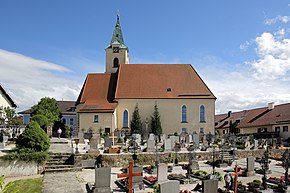Parish church Weyregg am Attersee
The Roman Catholic parish church Weyregg am Attersee is located in the center of the municipality Weyregg am Attersee in the Vöcklabruck district in Upper Austria . It is consecrated to St. Valentine and belongs to the pastoral care room Schörfling in the dean's office Schörfling . The church is a listed building .
history
- parish
After the King of Eastern Franconia and later Roman-German Emperor Heinrich II founded the Diocese of Bamberg in 1007, he gave it the Attergau , to which Weyregg also belonged. In 1115, the Bamberg bishops established the mother parish of St. Georgen im Attergau . This also included Weyregg as a branch. Weyregg was Protestant from 1570 to 1615 under Count Bartholomäus Khevenhüller and his caretaker Siegmund Widerroither. Weyregg was separated from St. Georgen around 1590. The pastors were still considered vicars and thus Weyregg was a branch of St. Georgen. Weyregg only became an independent parish in 1891 under Pastor Michael Dobler.
- church
The previous church, the foundation wall of which was discovered during renovation work on the chancel in 1972, was smaller and probably dates from the 14th century. The late Gothic church was built in the second half of the 15th century and is attributed to the master builder Stephan Wultinger from Vöcklamarkt . Originally, the rectangular church interior was designed as a two-aisled hall church with a pillar . From 1931 to 1933 major renovations and extensions were carried out. In 1931 the pillars were removed for liturgical reasons and the vault was added in a Gothic style. From November 1931 to September 1932, the church, which is now single-nave, was expanded by around eight meters to the west. After the church previously had only one roof turret, a steeple was also built in the southern choir corner , which was completed in 1933.
The church was renovated between 1947 and 1958 under Pastor Alois Kaiser . In 1972 , the Linz architect Erich Scheichl redesigned the sanctuary to meet the new liturgical requirements of the Second Vatican Council . Among other things, the neo-Gothic high altar (erected after 1880), the pulpit and the dining grill were removed, and the walled-in middle choir window was reopened.
Church building
The late Gothic choir with a ribbed vault is drawn in opposite the nave, has two yokes and a five-eighth end . The single nave nave has a ribbed vault with flat barrels.
Modern Secco paintings by Karl Weiser from 1951/52 can be found in the vaulted areas of the choir and on the nave walls . The three chancel windows from 1972 are also by Karl Weiser and have the themes: Faith, Love and Hope.
Furnishing
High altar
After the original neo-Gothic high altar was dismantled as part of the renovation work in 1972, Weyregg received a neo-Gothic altar on loan from the Radfeld parish in Tyrol in 1993 . On the occasion of Pastor Trauner's 80th birthday in 2004, it was given to the parish.
In the chancel there are two late Gothic statues from around 1500: St. Sebastian on the left, St. Valentine on the right. They come from the environment of the sculptor Lienhart Astl .
Side altars
The left side altar is a Marian altar with a crescent Madonna . This is essentially late Gothic (around 1520) and was heavily revised in the Baroque period . A restoration took place in 1953. The artist Klothilde Rauch added the rays.
The Sacred Heart Altar on the right is a modern winged altar that Karl Weiser created in 1953.
Stations of the Cross pictures
A total of 14 Stations of the Cross pictures are hung on the left and right walls of the nave. These were also created by Karl Weiser and consecrated in 1956. All images have a gold background, which symbolizes heaven and eternal joy.
organ
The organ, consecrated in 1963, has a mechanical action , two manuals and 16 stops . The construction of the organ was started by Hubert Neumann from Götzis and completed by Wilhelm Zika (Upper Austrian Organ Builders).
Bells
After the church tower was erected in 1933, it was rung in 1936. This was melted down as a metal donation from the German people during the Second World War . Today's bell (c, f sharp, a, h, c sharp) was cast in the St. Florian bell foundry from 1947 to 1958 and has a total weight of 3,048 kg.
literature
- Erwin Hainisch; Kurt Woisetschläger; u. a .: Dehio manual. The art monuments of Austria: Upper Austria, Weyregg am Attersee . 5th edition. Verlag Anton Schroll & Co, Vienna 1971, p. 377 .
Individual evidence
- ^ Upper Austria - immovable and archaeological monuments under monument protection. ( Memento from June 3, 2016 in the Internet Archive ) . Federal Monuments Office , as of June 28, 2013 (PDF).
- ↑ a b c d e f g h i j k Church guide No. 717/2008, Kunstverlag Peda, Passau 2008, ISBN 9783896437174
- ^ Diocese of Linz: Parish Weyregg am Attersee ; accessed on Jan 11. 2017
- ↑ a b Parish Church Weyregg am Attersee in attersee.salzkammergut.at
- ↑ a b Erwin Hainisch; Kurt Woisetschläger; u. a .: Dehio manual. The art monuments of Austria: Upper Austria, Weyregg am Attersee . 5th edition. Verlag Anton Schroll & Co, Vienna 1971, p. 377 .
Coordinates: 47 ° 54 ′ 7.9 " N , 13 ° 34 ′ 20.8" E



